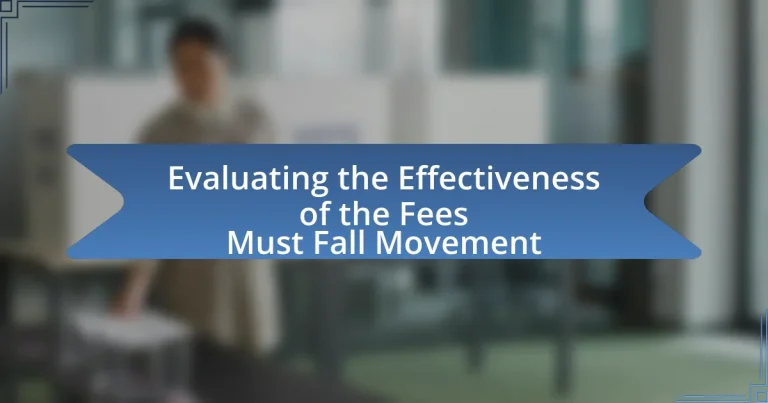The Fees Must Fall Movement is a significant student-led initiative in South Africa that began in 2015, advocating for the reduction and elimination of university tuition fees. This movement arose in response to rising educational costs, which disproportionately affected marginalized communities, and has mobilized thousands of students across various universities. The article evaluates the movement’s effectiveness by examining its origins, objectives, socio-economic factors, impact on public policy, and the challenges it has faced. It also discusses future prospects and lessons learned, highlighting the importance of collective action in advocating for accessible education.

What is the Fees Must Fall Movement?
The Fees Must Fall Movement is a student-led protest initiative in South Africa that began in 2015, advocating for the reduction and elimination of university tuition fees. The movement emerged in response to rising educational costs, which many students deemed unaffordable and discriminatory, particularly against marginalized communities. The protests gained significant traction, leading to national discussions on the accessibility of higher education and prompting the South African government to announce a freeze on fee increases for 2016. The movement’s impact is evidenced by its ability to mobilize thousands of students across various universities, highlighting systemic issues within the education sector and influencing policy debates regarding funding and equity in higher education.
What were the origins of the Fees Must Fall Movement?
The Fees Must Fall Movement originated in South Africa in 2015 as a response to the rising costs of higher education and the financial burden it placed on students. The movement began at the University of Cape Town when students protested against a proposed increase in tuition fees, which they argued exacerbated existing inequalities in access to education. The protests quickly spread to other universities across the country, highlighting systemic issues related to the commercialization of education and the legacy of apartheid. The movement’s demands included the call for free education and the decolonization of the curriculum, reflecting broader social justice issues within South African society.
How did student activism contribute to the movement’s inception?
Student activism was pivotal in the inception of the Fees Must Fall movement, as it mobilized a large number of students to advocate for affordable education in South Africa. The movement began in 2015 when students organized protests against rising tuition fees, highlighting the financial barriers to higher education. This grassroots mobilization was fueled by social media, which allowed students to share their experiences and grievances widely, thus galvanizing support across various universities. The protests led to significant national attention and discussions about the accessibility of education, ultimately influencing government policy and institutional responses regarding tuition fees.
What socio-economic factors led to the emergence of the movement?
The emergence of the Fees Must Fall movement was primarily driven by socio-economic factors such as rising tuition fees, increasing student debt, and systemic inequalities in access to higher education in South Africa. The rapid increase in university fees, which rose by over 10% annually in some cases, placed higher education out of reach for many students from low-income backgrounds. Additionally, the burden of student debt became unsustainable, with many graduates unable to find employment that would allow them to repay their loans. These economic pressures were compounded by historical inequalities rooted in apartheid, which left a legacy of unequal educational opportunities for marginalized communities. The combination of these factors galvanized students to demand affordable education and equitable access, leading to widespread protests and the formation of the movement.
What are the main objectives of the Fees Must Fall Movement?
The main objectives of the Fees Must Fall Movement are to eliminate tuition fees for higher education in South Africa and to advocate for accessible and quality education for all students. The movement emerged in response to the increasing financial burden of tuition fees, which many students deemed unaffordable and discriminatory. It aims to address systemic inequalities in the education system, ensuring that financial barriers do not prevent students from accessing higher education. The movement gained significant traction in 2015, leading to nationwide protests and discussions about the funding of public universities, highlighting the urgent need for reform in the higher education sector.
How does the movement aim to address tuition fees?
The Fees Must Fall movement aims to address tuition fees by advocating for the complete abolition of tuition costs at public universities in South Africa. This movement mobilizes students to demand free education, emphasizing that access to higher education should not be contingent on financial status. The movement gained significant traction following the 2015 protests, which highlighted the burden of rising tuition fees on students and their families. Evidence of its impact includes the South African government’s announcement in 2017 to implement a fee-free higher education policy for students from households earning below a certain income threshold, demonstrating the movement’s influence on national education policy.
What role does access to education play in the movement’s goals?
Access to education is central to the Fees Must Fall movement’s goals, as it advocates for affordable and equitable higher education for all South Africans. The movement emerged in response to rising tuition fees, which disproportionately affected marginalized communities, thereby limiting their access to educational opportunities. Research indicates that education is a key driver of social mobility and economic development; for instance, a study by the World Bank shows that each additional year of schooling can increase an individual’s income by up to 10%. By demanding accessible education, the Fees Must Fall movement aims to dismantle systemic barriers and promote inclusivity, ultimately striving for a more equitable society.
What impact has the Fees Must Fall Movement had on South African society?
The Fees Must Fall Movement has significantly impacted South African society by raising awareness about the financial barriers to higher education and advocating for affordable tuition. This movement, which began in 2015, mobilized thousands of students across the country, leading to widespread protests and discussions about the accessibility of education. As a result, the South African government announced a freeze on tuition fees for 2016 and initiated dialogues about funding models for higher education. Furthermore, the movement has influenced policy changes, such as the establishment of the Presidential Commission of Inquiry into the funding of higher education, highlighting the ongoing struggle for equitable access to education in South Africa.
How has the movement influenced public policy regarding education?
The Fees Must Fall movement has significantly influenced public policy regarding education by prompting the South African government to reconsider and reform its higher education funding policies. Following widespread protests and demands for free education, the government announced in 2017 that it would implement a phased approach to free higher education for students from poor and working-class backgrounds, as outlined in the Heher Commission report. This policy shift aimed to address the financial barriers faced by students and has led to increased government funding for universities, with a budget allocation of R57 billion over three years specifically for this purpose.
What changes have occurred in university funding as a result of the movement?
The Fees Must Fall movement has led to significant changes in university funding, primarily through increased government allocations and the introduction of new financial aid programs. Following the protests, the South African government committed to a multi-year funding plan that included a 2016 announcement of a 0% fee increase for universities, which was a direct response to the movement’s demands. Additionally, the government established the National Student Financial Aid Scheme (NSFAS) to provide more comprehensive support for low-income students, resulting in a substantial increase in funding for higher education. In 2018, the government allocated an additional R57 billion over three years to support universities, demonstrating a direct financial impact stemming from the movement’s advocacy for accessible education.

How effective has the Fees Must Fall Movement been?
The Fees Must Fall Movement has been effective in raising awareness about the financial barriers to education in South Africa and influencing policy changes regarding tuition fees. The movement successfully mobilized thousands of students across various universities, leading to significant protests that pressured the government and institutions to reconsider their tuition policies. For instance, in 2015, the South African government announced a freeze on tuition fee increases for 2016, a direct response to the movement’s demands. Additionally, the movement has sparked ongoing discussions about the broader issues of access to education and systemic inequality, highlighting the need for comprehensive reforms in the higher education sector.
What metrics can be used to evaluate the effectiveness of the movement?
Metrics that can be used to evaluate the effectiveness of the Fees Must Fall movement include changes in tuition fees, enrollment rates, and policy reforms. Specifically, the movement’s success can be measured by the percentage reduction in tuition fees achieved as a direct result of protests and negotiations, which was reported to be a 0% increase in 2016 for certain universities in South Africa. Additionally, tracking the number of students enrolled in higher education institutions before and after the movement can provide insights into its impact on accessibility. Lastly, the implementation of policy changes, such as the establishment of the Commission of Inquiry into Higher Education and Training, serves as a concrete indicator of the movement’s influence on national education policy.
How do we measure changes in tuition fees over time?
Changes in tuition fees over time are measured by analyzing historical fee data, typically collected from educational institutions, government reports, and financial records. This analysis often involves calculating percentage increases or decreases in fees over specific periods, such as annually or over several years. For instance, data from the National Center for Education Statistics indicates that average tuition and fees at public four-year institutions increased by 3.4% from the 2019-2020 academic year to the 2020-2021 academic year. Additionally, inflation-adjusted comparisons can provide insights into real changes in tuition costs relative to economic conditions.
What indicators reflect shifts in public opinion about education funding?
Indicators that reflect shifts in public opinion about education funding include public surveys, voting patterns on education-related ballot measures, and social media sentiment analysis. Public surveys, such as those conducted by organizations like Gallup, reveal changing attitudes toward education funding priorities, showing increased support or opposition over time. Voting patterns on ballot measures related to education funding, such as propositions for tax increases to support schools, provide concrete evidence of public sentiment, with significant shifts often correlating with economic conditions or social movements. Additionally, social media sentiment analysis can track real-time public discourse and sentiment regarding education funding, highlighting trends and shifts in opinion as they occur.
What successes has the Fees Must Fall Movement achieved?
The Fees Must Fall Movement has successfully influenced policy changes regarding university fees in South Africa. Notably, in 2015, the South African government announced a freeze on tuition fee increases for the 2016 academic year, a direct response to the protests initiated by the movement. Additionally, the movement has raised awareness about the broader issues of access to education and systemic inequalities, leading to ongoing discussions about funding models for higher education. These achievements highlight the movement’s impact on both immediate financial policies and long-term educational reform.
Which specific policy changes can be attributed to the movement?
The Fees Must Fall movement has led to specific policy changes, including the South African government’s decision to implement a zero percent increase in university fees for 2016 and the establishment of a commission to investigate the funding of higher education. These changes were a direct response to the widespread protests and demands for accessible education, highlighting the movement’s impact on national education policy. The government’s commitment to these changes was further reinforced by the announcement of increased funding for universities, aimed at addressing the financial barriers faced by students.
How have student enrollment rates been affected by the movement’s actions?
Student enrollment rates have decreased as a direct result of the Fees Must Fall movement’s actions. The movement, which advocates for free education in South Africa, has led to increased protests and disruptions in academic schedules, causing uncertainty among prospective students. According to a report by the Department of Higher Education and Training, enrollment figures dropped by approximately 10% in the years following the movement’s peak activities, indicating that many students opted not to enroll due to the instability and financial concerns surrounding tuition fees.
What challenges has the Fees Must Fall Movement faced?
The Fees Must Fall Movement has faced significant challenges, including government resistance, police violence, and internal divisions. Government resistance has manifested in the refusal to fully implement free education policies, despite widespread protests and demands from students. Police violence during protests has led to injuries and arrests, creating a climate of fear and discouraging participation. Additionally, internal divisions among student leaders and factions have complicated the movement’s unity and effectiveness, hindering its ability to present a cohesive front in negotiations with authorities. These challenges have impeded the movement’s progress and ability to achieve its goals.
How has government response impacted the movement’s effectiveness?
Government response has significantly impacted the effectiveness of the Fees Must Fall movement by shaping public perception and influencing the movement’s strategies. For instance, the South African government’s initial dismissal of student demands led to increased mobilization and radicalization among students, as evidenced by the escalation of protests in 2015 and 2016. Additionally, the government’s eventual concessions, such as the announcement of a fee freeze in 2016, demonstrated that sustained pressure from the movement could yield tangible results, thereby enhancing its credibility and support among the public. This interplay between government actions and student responses illustrates how governmental decisions can either hinder or bolster the movement’s overall effectiveness.
What internal conflicts have arisen within the movement?
Internal conflicts within the Fees Must Fall movement include ideological differences regarding the approach to achieving free education, as well as tensions between various student organizations and leadership structures. These conflicts have manifested in disagreements over whether to adopt more radical tactics or to pursue negotiations with the government. For instance, factions within the movement have clashed over the effectiveness of protests versus dialogue, leading to fragmentation and a lack of unified strategy. Additionally, issues of representation and inclusivity have surfaced, with some groups feeling marginalized within the broader movement, which has further complicated collective action and cohesion.

What are the future prospects for the Fees Must Fall Movement?
The future prospects for the Fees Must Fall Movement include continued advocacy for affordable education and potential policy changes in higher education funding. The movement has already influenced discussions around tuition fees in South Africa, leading to increased awareness of financial barriers faced by students. As of 2023, the South African government has committed to reviewing funding models for universities, indicating a shift towards addressing these issues. Additionally, the movement’s ability to mobilize students and engage with broader social justice issues suggests it will remain relevant in future educational reforms.
How can the movement sustain its momentum moving forward?
The movement can sustain its momentum moving forward by maintaining strong grassroots engagement and leveraging digital platforms for organization and communication. Grassroots engagement fosters a sense of community and shared purpose, which is essential for long-term commitment; for instance, the Fees Must Fall movement successfully mobilized thousands of students through localized protests and assemblies. Additionally, utilizing digital platforms allows for rapid dissemination of information and coordination of actions, as seen in the movement’s effective use of social media to organize events and share updates. This combination of community involvement and digital strategy has proven effective in maintaining momentum in social movements historically, such as the Arab Spring, where online platforms played a crucial role in mobilization and awareness.
What strategies can be employed to engage more students in activism?
To engage more students in activism, institutions can implement strategies such as integrating activism into the curriculum, providing platforms for student voices, and fostering partnerships with local organizations. Integrating activism into the curriculum allows students to learn about social issues and develop critical thinking skills, which can increase their interest in participating in movements like Fees Must Fall. Providing platforms, such as forums or workshops, enables students to express their views and collaborate on initiatives, enhancing their sense of community and purpose. Additionally, partnerships with local organizations can offer students real-world opportunities to engage in activism, thereby increasing their involvement and commitment. Research indicates that students who participate in structured activism programs are more likely to remain engaged in social issues long-term, demonstrating the effectiveness of these strategies.
How can the movement adapt to changing political landscapes?
The movement can adapt to changing political landscapes by employing strategic alliances, grassroots mobilization, and flexible messaging. Strategic alliances with other social movements or political organizations can amplify the movement’s voice and resources, as seen in various global protests where coalitions have strengthened advocacy efforts. Grassroots mobilization ensures that the movement remains connected to its base, allowing for rapid responses to political shifts, which was evident during the Fees Must Fall protests when student engagement was crucial in responding to government actions. Additionally, flexible messaging enables the movement to address current political issues while maintaining its core objectives, as demonstrated by the Fees Must Fall movement’s ability to pivot its focus from tuition fees to broader issues of access to education and systemic inequality in response to changing political contexts.
What lessons can be learned from the Fees Must Fall Movement?
The Fees Must Fall Movement teaches the importance of collective action in advocating for social justice and educational reform. This movement demonstrated that organized student protests can effectively challenge governmental and institutional policies, as seen in South Africa where students mobilized against rising tuition fees in 2015. The movement’s success in influencing policy changes, such as the South African government’s decision to freeze tuition fees for 2016, underscores the power of grassroots activism. Additionally, the movement highlighted the necessity of intersectionality, as it brought together diverse groups advocating for broader issues of access and equity in education.
How can other social movements benefit from the Fees Must Fall experience?
Other social movements can benefit from the Fees Must Fall experience by adopting its strategies of grassroots mobilization and coalition-building. The Fees Must Fall movement successfully engaged a diverse range of stakeholders, including students, academics, and community organizations, which amplified its impact and visibility. This approach led to significant policy discussions in South Africa regarding higher education funding, demonstrating the effectiveness of collective action. Additionally, the movement utilized social media to organize protests and disseminate information rapidly, showcasing the importance of digital platforms in modern activism. By learning from these tactics, other movements can enhance their outreach and effectiveness in advocating for social change.
What best practices can be identified for future activism?
Effective future activism can be guided by several best practices, including strategic coalition-building, leveraging social media for outreach, and maintaining clear messaging. Strategic coalition-building enhances the movement’s reach and impact by uniting diverse groups with shared goals, as seen in the Fees Must Fall Movement, which successfully collaborated with various student organizations and civil society groups. Leveraging social media allows for rapid dissemination of information and mobilization of supporters, evidenced by the movement’s ability to organize protests and share updates in real-time, reaching a wider audience. Maintaining clear messaging ensures that the core objectives are communicated effectively, which was crucial for the Fees Must Fall Movement in articulating its demands for affordable education. These practices collectively contribute to a more organized and impactful activist effort.
What practical steps can individuals take to support the Fees Must Fall Movement?
Individuals can support the Fees Must Fall Movement by participating in protests and rallies organized by the movement. Engaging in these events raises awareness about the issues surrounding educational fees and demonstrates solidarity with affected students. Additionally, individuals can contribute financially to organizations that support the movement, such as student unions or advocacy groups, which often require funds for legal support and campaign activities. Sharing information on social media platforms amplifies the movement’s message and can mobilize more supporters. Furthermore, individuals can engage in discussions about the movement in their communities, educating others on the importance of accessible education and the impact of high fees. These actions collectively enhance visibility and support for the Fees Must Fall Movement, contributing to its effectiveness in advocating for change.


